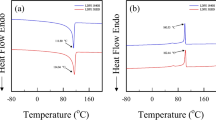Abstract
When a woven fabric is subject to a normal uniform loading, its properties such as tightness and through-thickness permeability are both altered, which relates to the fabric out-of-plane deformation (OPD) and dynamic permeability (DP). In this article, fabric OPD is analytically modelled through an energy minimisation method, and corresponding fabric DP is established as the function of loading and fabric-deformed structure. The total model shows the permeability a decrease for tight fabric and an increase for loose fabric when the uniform loading increases. This is verified experimentally by fabric OPD, static and dynamic permeabilities. Experimental tests for both permeabilities showed good agreement with the corresponding predictions, indicating the fact that tight fabric becomes denser and loose fabric gets more porous during OPD. A sensitivity study showed that an increase of fabric Young’s modulus or a decrease of fabric test radius both lead to an increase of DP for tight fabric and opposite for loose fabric. The critical fabric porosity and thickness were found for inflexion of fabric DP trend during the OPD, which contributes to the optimum design of interlacing structure applied to protective textiles and composites.
















Similar content being viewed by others
References
Somodi Z, Rolich T, Hursa A (2010) Micromechanical tensile model of woven fabric and parameter optimization for fit with KES data. Text Res J 80(13):1255–1264
King MJ, Jearanaisilawong P, Socrate S (2005) A continuum constitutive model for the mechanical behavior of woven fabrics. Int J Solids Struct 42:3867–3896
Lin H, Clifford MJ, Taylor PM, Long AC (2009) 3D mathematical modeling for robotic pick up of textile composites. Compos B 40:705–713
Gebart BR (1992) Permeability of unidirectional reinforcements for RTM. J Compos Mater 26(8):1101–1133
Cai Z, Berdichevesky AL (1993) An improved self-consistent method for estimating the permeability of a fiber assembly. Polym Compos 14(4):314–323
Bruschke MV, Advani SG (1993) Flow of generalized Newtonian fluids across a periodic array of cylinders. J Rheol 37(3):479–497
Westhuizen JV, Plessis JPD (1996) An attempt to quantify fibre bed permeability utilizing the phase average Navier–Stokes equation. Compos A 27A:263–269
Advani SG, Bruschke MV, Parnas RS (1994) Resin transfer molding flow phenomena in polymeric composites. In: Advani SG (ed) Flow and rheology in polymer composites manufacturing. Elsevier, Amsterdam
Kulichenko AV (2005) Theoretical analysis, calculation, and prediction of the air permeability of textiles. Fibre Chem 37(5):371–380
Xiao X, Zeng X, Long A, Cliford MJ, Lin H, Saldaeva E (2012) An analytical model for through-thickness permeability of woven fabric. Text Res J 82(5):492–501
Phelan JF, Wise G (1996) Analysis of transverse flow in aligned fibrous porous media. Compos A 27A(1):25–34
Ugural AC (1999) Stresses in plates and shells, 2nd edn. McGRAW HILL International editions, Singapore, p 502
Ly NG, Tester DH, Buckenham P, Roczniok AF, Adriaansen AL, Scaysbrook F, De Jong S (1991) Simple instruments for quality control by finishers and tailors. Text Res J 61(7):402–406
Image-J (2012) Available from: http://rsbweb.nih.gov/ij/features.html. Accessed on 2012 17/05
Chan CK, Jiang XY, Liew KL, Chan LK, Wong WK, Lau MP (2006) Evaluation of mechanical properties of uniform fabrics in garment manufacturing. J Mater Process Technol 174(1–3):183–189
Hursa A, Rolich T, Razic SE (2009) Determining pseudo Poisson’s ratio of woven fabric with a digital image correlation method. Text Res J 79(17):1588–1598
Bandara P, Lawrence C, Mahmoudi M (2006) Instrumentation for the measurement of fabric air permeability at higher pressure levels. Meas Sci Technol 17:2247–2255
Xiao X, Zeng X, Bandara P, Long A (2012) Experimental study of dynamic air permeability for woven fabrics. Text Res J 82(9):920–930
Lu Y, Dai X (2009) Calculation of fabrics Poisson’s ratio based on biaxial extension. J Text Res 30(9):25–28
Acknowledgements
The authors would like to thank Airbags International Ltd. for providing experimental materials, Leeds University and UK Unilever Resources Centre for undertaking the experimental tests.
Author information
Authors and Affiliations
Corresponding author
Rights and permissions
About this article
Cite this article
Xiao, X., Long, A. & Zeng, X. Through-thickness permeability modelling of woven fabric under out-of-plane deformation. J Mater Sci 49, 7563–7574 (2014). https://doi.org/10.1007/s10853-014-8465-z
Received:
Accepted:
Published:
Issue Date:
DOI: https://doi.org/10.1007/s10853-014-8465-z




